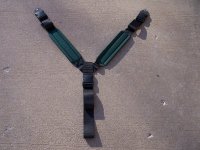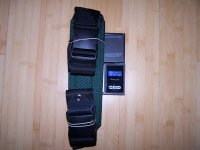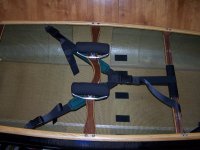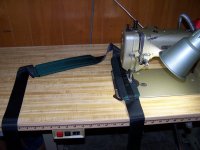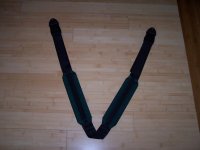-
Happy First Sighting of Manatees by Columbus (1493)! 💧🐘
You are using an out of date browser. It may not display this or other websites correctly.
You should upgrade or use an alternative browser.
You should upgrade or use an alternative browser.
anyone ever make their own removable yoke?
- Thread starter Trevor27
- Start date
Yes, I followed the directions in Cliff Jacobson's book though I think I may try one of the webbing designs described by Mike M.
I bought a removable clamp-on yoke in 1984 that fits narrow solo canoes, and I still use it. Good as new. Here it is in its non-portage position being used as a clothes line:
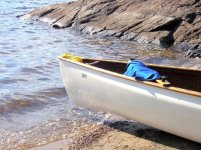
For my tandem canoes I semi-made a removable yoke. That is, I bought a raw wooden yoke and then drilled slots and installed my own metal L clamps and knobs. I believe I re-used the hardware from a motor mount I was no longer using.
If you want a properly centralized solo seat in a canoe, you can't have a fixed central portage thwart. You have to use a removable yoke. A portage strap could be used instead of a clamp-on yoke, but I don't think it would be comfortable or optimal other than for short carries.
There are other DIY yokes I've seen that attach onto the centralized solo seat rather than onto the gunwales. Maybe someone here has made or used one.

For my tandem canoes I semi-made a removable yoke. That is, I bought a raw wooden yoke and then drilled slots and installed my own metal L clamps and knobs. I believe I re-used the hardware from a motor mount I was no longer using.
If you want a properly centralized solo seat in a canoe, you can't have a fixed central portage thwart. You have to use a removable yoke. A portage strap could be used instead of a clamp-on yoke, but I don't think it would be comfortable or optimal other than for short carries.
There are other DIY yokes I've seen that attach onto the centralized solo seat rather than onto the gunwales. Maybe someone here has made or used one.
I've made a couple for solos, pretty much identical to what you can buy. Easy to make. Looks like Glenn's. I think the I got the basic shaped thwart from Wenonah for maybe $30, and added a clamp with hardware stuff and portage pads.
I have seen a homebuilt design that hinges from back of bench seat. Seemed smart. I think details at bwca.com. I'll stick with spring creek clamp-on.
Link to pics of the yoke set up on my solo prospector.

 www.instagram.com
www.instagram.com

Sid Bredin on Instagram: "It appears that the BC travel ban will be lifted allowing us to travel out of our health regions on the 16th 👍. I’m scheduled for my 2nd jab on the 17th and the plan is to head out on the 20th for a 5 night canoe trip 🛶. So,
Sid Bredin shared a post on Instagram: "It appears that the BC travel ban will be lifted allowing us to travel out of our health regions on the 16th 👍. I’m scheduled for my 2nd jab on the 17th and the plan is to head out on the 20th for a 5 night canoe trip 🛶. So, I finally got around to...
 www.instagram.com
www.instagram.com
I covered off making a fairly simple removable yoke 2 builds ago here:
http://buildersforum.bearmountainboats.com/viewtopic.php?f=3&t=2006&start=75
Just scroll down a few pics until you get to where the yoke build starts
Brian
http://buildersforum.bearmountainboats.com/viewtopic.php?f=3&t=2006&start=75
Just scroll down a few pics until you get to where the yoke build starts
Brian
A simple and effective way to make a basic removable yoke is with a pair of hinges - I outlined how I did mine here: https://www.canoetripping.net/threads/10-pound-challenge.98006/post-116695
A strap yoke might also work for you. Most would use it for the short trip from vehicle to water, but it can work fine even for extended carries if your canoe is lightweight (say 30 pounds or less). Good discussion starts here https://www.canoetripping.net/threads/strap-yoke-variation.74927/post-74927
A strap yoke might also work for you. Most would use it for the short trip from vehicle to water, but it can work fine even for extended carries if your canoe is lightweight (say 30 pounds or less). Good discussion starts here https://www.canoetripping.net/threads/strap-yoke-variation.74927/post-74927
If you don't mind a drilling into your gunnels I came up with an easy solution. I took a 1 by 3" board and screwed it to the top of the gunnels with wing nuts and attached portage pads to it. When I was paddling I only unscrewed one side and swung the yoke forward out of the way of my legs. That way I only had to do one side with a quick tightening on the other.
I did make my own, but attachment was not straight forward.
I ran a thread on it here:
I ran a thread on it here:
Why did I wait so long???
I have a short trip planned for mid October, and, there's an unknown amount of carrying where there are no trails. I have an old portage thwart from one of my builds from 1984, it used to be a pretty cedar laminate, that fit my 30 year old physique perfectly. Well, I ain't 30 any more, and that...
www.canoetripping.net
I have a purchased wood yoke, similasr to Glenn's that I use for my Rapidfire. Works great, it even goes in and out very fast when I am portaging during the Adirondack 90 mile canoe race. It doesn't fit my Hornbeck. For that I bent 1.5" lighweight aluminum conduit into a yoke shape, put some padding on it. flattened the ends, and attached wing nut bolts through the wood gunwales. The yoke carrier supports on the top tubes of my knupac backpack fit into it. I also attatch a smaller aluminum conduit from the bottom of my backpack to a point near the rear of one side of the gunwale. It works great and makes a solid hands free carry.
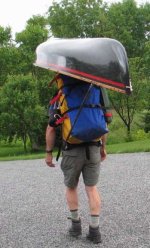

IMO it is important for a removable yoke to have a few inches of adjustment fore and aft of the balance point. The sweet spot can move if items carried in the canoe vary. For example, most of the time, I carry a single carbon paddle but sometimes will want two wooden paddles strapped inside. Therefore, I prefer a clamping system rather than a set point of attachment. My first store bought yoke was universal, i.e. adjustable to a wide range of beam widths and inwale thicknesses. It had two stepped gunwale attachment gizmos that were slippery and awkward to use, it worked, but took too much time and was very heavy.
My advice in designing a removable yoke is to ignore any idea of universal use between canoes. Build for what you own. Clamps don't need to be made of thick metal, rubber gasket material makes a good grippy pad against a gunwale and lighter is better.
My advice in designing a removable yoke is to ignore any idea of universal use between canoes. Build for what you own. Clamps don't need to be made of thick metal, rubber gasket material makes a good grippy pad against a gunwale and lighter is better.
I have one very similar (if not the same) as Glenn's. Mine has aluminum clamps so I glued on some ccf so as to not damage wood gunwales.
I have the balance point of my canoe marked with a piece of tape on each side, so I know exactly where to place the yoke clamps in a hurry. The clamps on the commercial yoke are tightened with large knurled knobs. They do not have to be super tight to hold firm and I have not noticed any damage on my Rapidfire wood gunwales. The adjustement point does not really change when I store my paddle centered underneath. With my Rapidfire I have a hand line going from bow to stern clipped together in the middle, long enough to comfortably grip it at hip level with one hand. It controls the tilt of bow/stern as I walk. The bolt holes for my custom bent tubing yoke are in one fixed location in my Hornbeck gunwales. I don't worry about yoke balance adjustment with my Hornbeck because the bottom support rod makess the whole contraption fixed and rigid.I have one very similar (if not the same) as Glenn's. Mine has aluminum clamps so I glued on some ccf so as to not damage wood gunwales.
Can you describe how your strap yoke mounts? I was trying to invent something like your picture for my solo peregrine canoeI made a strap yokes.
- Joined
- Oct 11, 2020
- Messages
- 229
- Reaction score
- 363
I considered purchasing a solo canoe and wanted a carry yoke that was lightweight, quick to deploy, easy to stow and would not be lost or misplaced. I often make and modify equipment so this became a DIY project.Can you describe how your strap yoke mounts? I was trying to invent something like your picture for my solo peregrine canoe
I based my design on the Military LC-2 Y harness suspenders. It has 3 points of contact, front port gunnel, front starboard gunnel and rear thwart. The photo is of the prototype that I made for testing. I used adjustable side release buckles so that I could easily attach and adjust it to fit my tandem canoe for testing.
This is a DIY project so materials, mounting hardware and fitment are up to you. The yoke requires custom fitting and may not be compatible with all solo canoes. Through testing I was able to simplify the prototype design and address issues such as head clearance.
John
P.S.
I considered 1-2-3 and 4 strap configurations. I chose a 3 strap design but another configuration may better meet your requirements.
I found a photo that show the approximate location that I mounted the prototype for testing. Of course a solid yoke is more efficient for a tandem and I had to remove the solid yoke for testing. Also, the rear strap in the photo is wrapped around the rear kneeling thwart and the kneeling thwart is positioned 2 inches below the gunnels which would reduce head clearance by 2 inches. The angle, strap length and mounting location effect how the canoe carries and whether your head bounces off the deck of the canoe when you walk. Depending on your canoe design it my be necessary to add tower brackets at the mounting locations to increase head clearance.
There are pros and cons to consider when constructing and installing but I enjoy finding workable solutions and I feel that a strap yoke would work better than a solid removable yoke on a solo canoe for my intended purpose.
Attachments
Last edited:
- Joined
- Oct 11, 2020
- Messages
- 229
- Reaction score
- 363
There are many removable carry yoke designs available that can be copied in part or whole and installed on a solo canoe. Solid removable clamp on yokes are the most common.
I considered making or modifying a Swift Packable Yoke so that it attached directly to the gunnels with quick connect fasteners instead of the wrap around straps.
I also considered making a Paddle Yoke.
I considered making or modifying a Swift Packable Yoke so that it attached directly to the gunnels with quick connect fasteners instead of the wrap around straps.
I also considered making a Paddle Yoke.
Similar threads
- Replies
- 14
- Views
- 989
- Replies
- 27
- Views
- 2K
- Replies
- 12
- Views
- 835

